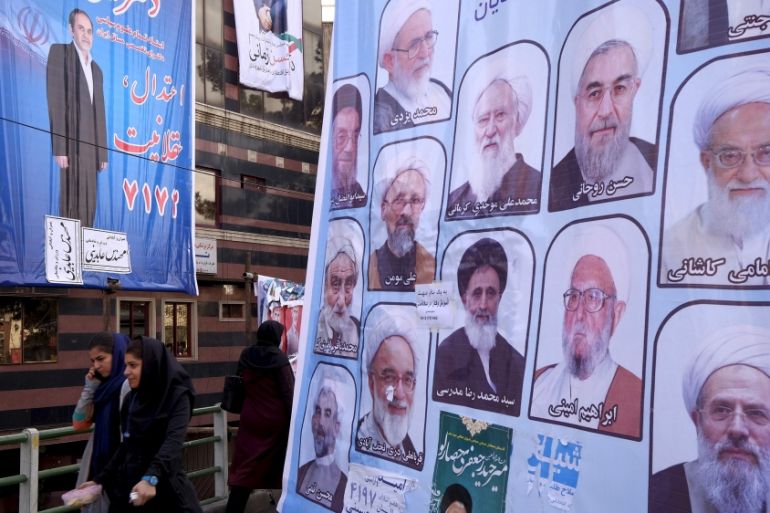Iran elections: What you need to know about key vote
As the Islamic Republic prepares to hold important nationwide elections, here is what you should know about them.

Voters in Iran are heading to the polls on Friday in the country’s first parliamentary election after the implementation of a nuclear deal between Tehran and world powers.
The vote is seen by many analysts as a potential battleground between hardliners in the country and those reformists who have seen their powers wane over the past decade.
Keep reading
list of 4 itemsWho will be Iran’s next president? | Start Here
Oil slumps two percent on possible return of Iranian supply
Border security a common concern for Pakistan and Iran: Rouhani
On the eve of the important nationwide elections, here is what you need to know.
Who are the candidates?
On Friday, votes will be cast for Iran’s two major political institutions: the Parliament and the Assembly of Experts.
More than 6,200 candidates, including 586 women, are vying for Iran’s 290-seat parliament. In the capital Tehran alone, more than 1,000 candidates are competing for 30 seats.
A large number of reform candidates have been blocked from running by the Guardian Council, the body of clerics and jurists who are allied with Iran’s Supreme Leader Ayatollah Ali Khamenei.
READ MORE: Voices from Iran – voters hope for economic growth
In a sign of the apparatus employed by the state to control elections, more than 12,000 people initially registered as candidates – but more than half were disqualified, in a process seen by many as opaque.
In the other election for the Assembly of Experts, 800 people applied to stand – but the Guardian Council cleared just 161 of them and disqualified all female applicants.
Overall, 88 members will be chosen in the influential body – its members monitor the work of the supreme leader and choose his successor.
Is a high voter turnout expected?
Parliamentary elections rarely inspire the same enthusiasm as presidential elections in Iran.
Presidential elections held in 2013 saw a voter turnout of nearly 73 percent.
WATCH: Iran gears up for parliamentary elections
In comparison, the parliamentary elections of 2012, which were boycotted by many moderates and reformists in the wake of the contested 2009 presidential elections and a subsequent crackdown, around 64 percent of Iranians voted.
What is the state of the reform movement?
Last week, the grandson of the Islamic Republic’s founding father, Ayatollah Ruhollah Khomeini, who is widely viewed as a future leader of the country’s reformist movement, was among those who was prevented from competing.

His disqualification is seen by analysts as an important indication of state control over the elections.
“That message is: We do not share any power with you,” said Nader Karimi Joni, a journalist close to the reformist movement. “The more reformists in the Assembly, the more chance they will get to pick a new leader closer to their line of thinking.”
Why is the Assembly vote significant?
There is an added importance to this year’s Assembly elections since, in theory, it is the body that can replace the supreme leader.
Khamenei is currently 76 and it remains highly likely that either during or after his next eight years, members will vote for a replacement.
Reformists and moderates are looking to take advantage of the situation by throwing their weight behind former president, Ayatollah Ali Akbar Hashemi Rafsanjani.
READ MORE: Telegram chat app may be game-changer in Iran elections
Rafsanjani, 80, was the president of the Islamic Republic from 1989 to 1997 and is seen as one of its founding members.
After the 1979 Islamic Revolution, he was the first speaker of parliament, before becoming the commander-in-chief of the country’s armed forces during the protracted Iran-Iraq war.
When Ayatollah Khomeini died in 1989, Rafsanjani was crucial in the appointment of Khamenei. He is now head of the expediency council, which acts as a bridge between Parliament and the Guardian Council.
Reform vs status quo
Reformists are hoping that Rafsanjani can block support for three ultra-conservative leaders, Mohammad Taghi Mesbah-Yazdi, Ahmad Jannati and Mohammad Yazdi.
The election will also be seen as vote of confidence in President Hassan Rouhani, who has two years remaining in his presidency and is tipped to run again in 2017.
Rouhani’s stewardship of the Iranian economy after the lifting of sanctions will be a key component of his campaign in 2017.
While it is too early to see any improvement on the Iranian economy – and with oil trading at historically low prices – Rouhani has been instrumental in attracting foreign business delegations to Tehran over the past 20 months.
He has also undertaken important visits to France and Italy to attract investment to the country.